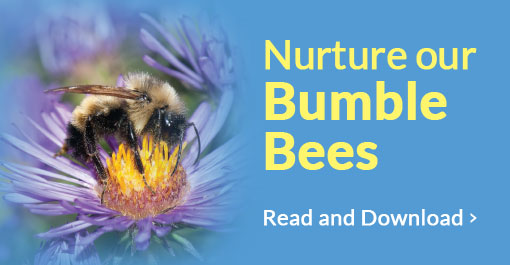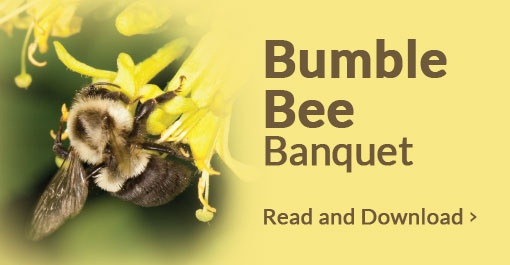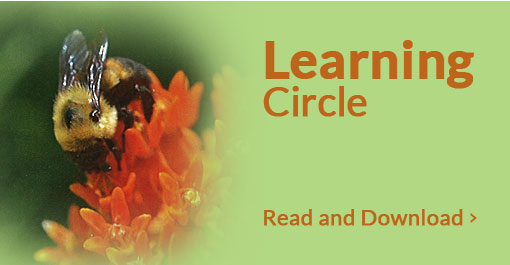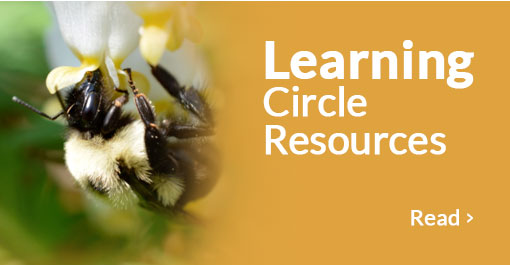2014 Nurturing Pollinators
A prairie management priority!
The vitality of our prairie pollinators can be a force multiplier to strengthen our prairie preserves and adjacent 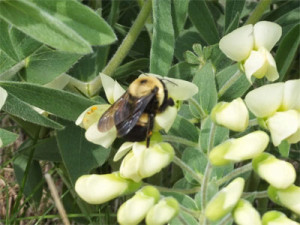 agriculture fields. A recent study by Emory University researcher Berry Brosi and UCal ecologist Heather Briggs finds that removing a single species of bumblebees has a swift and clear impact: “desirable flowering plants produce significantly fewer seeds”
agriculture fields. A recent study by Emory University researcher Berry Brosi and UCal ecologist Heather Briggs finds that removing a single species of bumblebees has a swift and clear impact: “desirable flowering plants produce significantly fewer seeds”
As landowners, and not professional biologists, our family has enjoyed learning more about the powerful contribution of pollinators and especially bumblebees. We appreciate more their role in the regeneration and resilience of our prairie landscape and the productivity of our organic vegetable gardens.
Globally bees are the most important pollinators. They have co-evolved with their floral resources. For millions of years, an annual life sustaining drama has unfolded. As the spring sun warms the earth, queen bees slowly emerge after months of hibernation in protective underground chambers. She is alone in this chilly world; the rest of the family from the previous season has perished. The queen has mated the previous fall and carries with her the nascent future colony as fertilized but undeveloped eggs. As the queen slowly emerges, it will be imperative that she be able to locate and provision a suitable nest with nectar and pollen from early blooming plants. As a land manager, I am assuring that the emerging bees find available sources of early season forage i.e. locally appropriate flowering native plants. Pollen provides protein to complete the queen’s ovary development so that she can begin laying eggs.
A suitable nest be pre-existing such as an abandoned rodent hole, a man-made structure, a clump of grass or brush pile. Research seems to suggest one very limiting factor for bumble bee success is lack of suitable undisturbed sites. Ground-nesting solitary bees need access to sunny, well-drained patches of bare ground. Suitable sites can be developed either by manually clearing vegetation from a small area or by creating a sand pit. For the latter, dig down one to two feet in an open, well-drained spot and fill with a sandy loam mix. Be sure to keep this area relatively free of vegetation. Keeping some portion of your flower bed free of mulch, exposing soil, is a quick and easy way to provide habitat for ground-nesting bees.
Once the nest site is established, the queen will gather soft nesting material, often fine grasses. With her body she fashions a cavity in the center of the nest. From her body the queen extrudes thin strands of wax that she will form a honey cup. This structure will become a focal point in the nursery for developing bees. During this hectic period, the queen is continually foraging for food, while tending her brood. She must continually keep them warm especially during the chilly spring nights.
It takes approximately three weeks for a young bee to develop. The first young workers are helped out of the cocoons by their mother. They will continue to take nourishment from the honey pot until they forage themselves. Once an early generation of bees has matured they can assist their mother foraging for food and brooding the young. This frees the mother to focus on laying eggs. Once the early development of the bee family has been t achieved the numbers in the family can rapidly multiply. Family building provides willing workers to devote themselves to seeking food and indirectly providing critical pollination service to the flowering plant community that includes many food resources.
Famed ecologist Bernd Heinrich provides an elegant scientific summary that describes how plants depend on a robust population of pollinators and vice versa. While the plants are dependent on adequate level of visits by pollinating bees (or other pollinators), the bee family requires continuous nourishment. This typically requires a season long progression of nectar rich blooming plants. As land managers we must discern how we can orchestrate the various rhythms to enhance the tempo of natural cycles to assure that the mutual needs of the plants and the pollinators can be adequately matched. Heather Holm’s just released book provides beautifully illustrated practical advice for our area.
The Nelson Family Farm (https://nelsonfamilyfarm.org) in Dakota County Minnesota has become a “sweet spot” not only for native bees but also bee enthusiasts. Regular cohorts of enthusiasts have been visiting our prairie to appreciate the serendipity and subtle interdependence of pollinator and plant. Land managers are partnering with each other to learn and share experiences about how we can optimize that beautiful life regeneration cycle. Look for an Open House as part of the Prairie Enthusiasts summer tour schedule.
Berry J. Brosi and Heather Briggs Proceedings of the National Academy of Sciences 1307438110 June 2013 Print
Heinrich, Bernd. Bumblebee Economics. Cambridge: Harvard Press, 2004. Print
Heather Holm. Pollinators of Native Plants. Minnetonka: Pollination Press, 2014 Print




